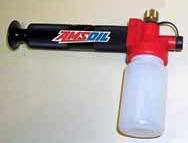Oil Sampling Methods
1. The component sampled should be brought to operating temperature prior to sampling. This will assure that the insoluble and semi-soluble material is suspended evenly throughout the system. Samples taken from components that have been inactive for long periods are not representative.
2. Sample should always be taken in the same manner and from the same point.
3. Do not sample a component directly after an oil change or after a large amount of makeup oil has been added.
4. Use a clean, dry, unbreakable container. Never reuse containers or sampling tubing.
1. Sample Pump Method
(See Instructions For Use)Request a sample pump when ordering your sample kit. The pump will come with complete instructions and will enable you to draw a sample quickly and easily. Seal the bottle tightly.
2. Sample Valve/Petcock Method
The valve should be wiped clean and any stagnant oil should be drained prior to catching a sample run. Seal the bottle tightly. Wipe bottle clean.
3. Oil Drain Method
Clean the area around the drain plug thoroughly to avoid sample contamination. Allow oil to drain for three to five seconds prior to catching a sample. Place a clean, dry sample bottle in the oil stream and fill to within 1/2 inch of the top. Seal bottle tightly. Wipe bottle clean.
- For best results, oil samples should be taken immediately after equipment shutdown, while the equipment is still at operating temperature. It is best to sample your engine at operating temperature just after engine shut-down. This will provide optimized results that more closely simulate “real-world” particle distribution throughout the lubricant. Dirt, water and other debris tend to settle to the bottom of the reservoir while light fuels tend to float. This separation will compromise your analysis.
- Good locations for sampling include an oil gallery, the engine crankcase, the drain plug or dipstick tube and the equipment reservoir or sump.
- When taking oil from industrial machinery through a bottom drain, be careful to draw oil until your sample has a uniform, representative appearance.
- Use samples from the drain pan or oil filter only as a last resort. For a failed engine that has had the oil drained, a drain pan or oil filter sample may help detect the cause of the failure.
- Avoid prolonged skin contact with used oil. Wash exposed skin with soap and water after exposure.
CAUTION
Engine crankcase oil temperatures can exceed 200°F. To avoid
personal injury, use protective equipment such as gloves, safety
glasses and protective clothing.

